The Women’s WOC 2016 Long distance race was special in that there were big time difference already at the 2nd control. Many runners lost the race already at the 3.5 kilometer long leg to the 2nd control.
The battle for victory was between the eventual winner Tove Alexanderseson (Sweden) and Russian silver medalist Natalia Gemperle. Gemperle got the initiative in the race by winning the long 2nd leg with one minute, and soon after catching Judith Wyder (Switzerland, 4th in the competition). Gemperle and Wyder ran together for the rest of the competition. Alexandersson ran a poor 2nd leg, and lost 3 minutes to Gemperle on this leg. The rest of the race Alexandersson ran a better technical race than Gemperle, gradually getting closer to Gemperle and in the end winning with 26 seconds. One key to Alexandersson’s win in this race is her performance on the leg to control 9 which she wins with 52 seconds. Another key to the victory is catching Hausken at the 9th control – the two are together from the 9th control to the finish, mostly with Hausken in front.
The following analysis focuses on how the race was decided and the decision points in the race. Before the analysis the final results links to map and GPS-tracking is given.
Final results & course
| 1. | Tove Alexandersson | SWE | 86:24 | (+0:00) |
| 2. | Natalia Gemperle | RUS | 86:50 | (+0:26) |
| 3. | Anne Margrethe Hausken Nordberg | NOR | 88:25 | (+2:01) |
| 4. | Judith Wyder | SUI | 88:43 | (+2:19) |
| 5. | Saila Kinni | FIN | 94:14 | (+7:50) |
| 6. | Anastasia Denisova | BLR | 94:22 | (+7:58) |
| 7. | Mari Fasting | NOR | 94:33 | (+8:09) |
| 8. | Emily Kemp | CAN | 95:54 | (+9:30) |
| 9. | Heidi Bagstevold | NOR | 96:31 | (+10:07) |
| 10. | Sabine Hauswirth | SUI | 96:33 | (+10:09) |
| 11. | Julia Gross | SUI | 97:12 | (+10:48) |
| 12. | AnniMaija Fincke | FIN | 97:14 | (+10:50) |
| 13. | Anastasia Rudnaya | RUS | 97:23 | (+10:59) |
| 14. | Lina Strand | SWE | 97:44 | (+11:20) |
| 15. | Emma Johansson | SWE | 98:58 | (+12:34) |
WOC 2016 - Long women

» See map in omaps.worldofo.com
Splitsbrowser visualization & GPS Animation
The fight for victory was close; Natalia Gemperle (lost 1:21 at leg 9, finished 26 seconds behind in 2nd) and Anne Margrethe Hausken Nordberg (lost 2:13 at leg 2, finished 2:01 behind in 3rd) were only one control away from beating Tove Alexandersson. Natalia Gemperle lost 1:21 or less to the leg winner on all legs (which is quite much) – that was least of all runners in this race.
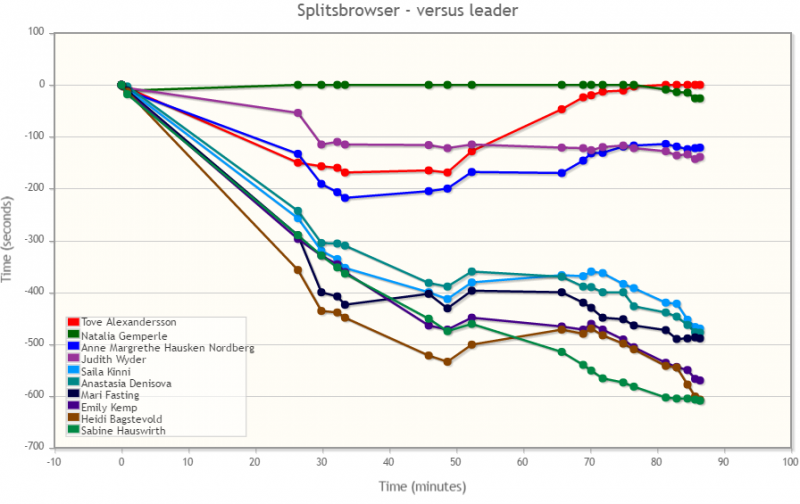
Here is also a GPS visualization of the battle between the top runners:
Decisions point: The second control
Looking at the split time illustration, it is clear that Natalia Gemperle ran a fantastic leg to the second control. Only 3 runners are within 4 minutes behind Gemperle after the long leg; Judith Wyder, Anne Margrethe Hausken Nordberg and Tove Alexandersson. This is not a leg where you necessarily win the race, but there were many runners losing the race already here. This animation of the top runners on this leg illustrates the time differences – and how most of the runners running straight struggle with the execution:
The reason for Gemperle’s good performance on the long leg is that she is the only of the top runners who runs the road to the right. In addition none of the top runners execute the leg perfectly on the straight route. Alexandersson who loses 3 minutes struggles both on the routechoice and in the execution, doing a mistake a few hundred meters before the control and getting stuck several times.
Note that in the analysis of the men’s class, running straight and right was found to be approximately equal.
Here is a comparison between Gemperle and Alexandersson:
Tricky third control: Gemperle catches Wyder
Both Wyder and Hausken Nordberg lose time also to the 3rd control due to mistakes. It looks like the reason for the time loss is inaccurate orienteering into the control. Both Gemperle and Alexandersson run well on this leg.
This gives huge time differences already at the 4th control where Natalia Gemperle is in the lead 1:50 ahead of Judith Wyder with only 7 women within 5 minutes:
| 1. | Natalia Gemperle | RUS | 32:14 | (+0:00) | Total: 86:50 (2) |
| 2. | Judith Wyder | SUI | 34:04 | (+1:50) | Total: 88:43 (4) |
| 3. | Tove Alexandersson | SWE | 34:54 | (+2:40) | Total: 86:24 (1) |
| 4. | Anne Margrethe Hausken Nordberg | NOR | 35:41 | (+3:27) | Total: 88:25 (3) |
| 5. | Anastasia Rudnaya | RUS | 37:07 | (+4:53) | Total: 97:23 (13) |
| 6. | Anastasia Denisova | BLR | 37:20 | (+5:06) | Total: 94:22 (6) |
As Gemperle started 2 minutes behind Wyder, Gemperle has caught up with Wyder at this point in the course and they are running together. Actually they are running together all the way from the 4th control to the finish, sharing the number of legs they punch first. Tove Alexandersson on the other hand started 2 minutes before Norwegian Anne Margrethe Hausken Nordberg – and at this point in the course they are not together.
Routechoice leg to control 6
The routechoice leg to control 6 is again more about execution than about routechoice. Going around to the right on the path seems to be slightly faster than direct – but you can run the direct route in nearly the same speed. For most of the runners it would probably have been best to run around to the right here, as the risk for getting stuck in the cliffs at the middle of the leg is high, compared to a lot easier execution when running around to the right.
Control 8: Mistake by the Gemperle/Wyder pair
After excellent performance all the way to the 7th control, Gemperle starts to make mistakes at the 8th control. Her routechoice is not optimal, and towards the control she is influenced by Wyder’s mistake and loses 41 seconds. This starts Gemperle’s worst period in the race – losing more than 2 minutes of her 2:49 lead to Alexandersson on the 8th and 9th leg together.
Control 9: Alexandersson crushes the competition
A key factor in Alexanderssons win was her great performance to the 9th control. Alexandersson wins this leg with 52 seconds ahead of Bagstewold with Saila Kinne as the second best at +52 seconds. Alexandersson does nothing special on this leg apart from running straight with high speed. It is the last part of the leg into the control where she excels – maybe she runs faster here because she starts seeing Hausken Nordberg? Gemperle/Wyder run a similar route as Alexandersson, but lose time into the control. When arriving at control 9, Alexandersson has caught nearly two minutes on Gemperle since the second control.
Here you can see Alexandersson compared with Gemperle; Gemperle’s routechoice costs her around 30 seconds, the mistake into the control another 50 seconds. Next is a comparison between Alexandersson and Bagstevold who is second fastest on the leg. Bagstevold is nearly equal until they come to the house after 2/3 of the leg – from there Alexandersson is faster. Bagstevold loses time because she gets insecure and starts running slowly down the tricky slope towards the control. Finally a comparison between Alexandersson and Kinni; Kinni takes the safe routechoice along the path to the right, it is clear from the comparison that you lose at least 30-40 seconds against the perfect execution straight of Alexandersson by running right – but compared to the other runners the timeloss on this risk reduction choice is not that big.
This is the standing at control 9.
| 1. | Natalia Gemperle | RUS | 65:45 | (+0:00) | Total: 86:50 (2) |
| 2. | Tove Alexandersson | SWE | 66:32 | (+0:47) | Total: 86:24 (1) |
| 3. | Judith Wyder | SUI | 67:46 | (+2:01) | Total: 88:43 (4) |
| 4. | Anne Margrethe Hausken Nordberg | NOR | 68:35 | (+2:50) | Total: 88:25 (3) |
| 5. | Saila Kinni | FIN | 71:52 | (+6:07) | Total: 94:14 (5) |
| 6. | Anastasia Denisova | BLR | 71:55 | (+6:10) | Total: 94:22 (6) |
| 7. | Mari Fasting | NOR | 72:25 | (+6:40) | Total: 94:33 (7) |
| 8. | Emily Kemp | CAN | 73:31 | (+7:46) | Total: 95:54 (8) |
At this point in the course Alexandersson is only 47 seconds behind Gemperle, and has thus caught up with most of the advantage Gemperle had.
Last part of the course: Middle characteristics
From this point in the course, the course changes characteristics from long legs (long distance) to shorter legs (middle distance). Gemperle goes into this part of the race with a 47 second lead to Alexandersson.
In this part of the course from control 9 to the finish Gemperle loses 1:17 to Alexandersson. If you look at the GPS comparison, you see that Alexandersson is faster than Gemperle nearly all of the way – there is no special mistake by Gemperle where Alexandersson is significantly faster. According to the post-race interviews, Hausken was in front of Alexandersson in the forest most of the way from the 9th control to the finish, pushing very hard.
The grouping between Alexandersson/Hausken and Gemperle/Wyder has surely influenced the results. Did Hausken pull Alexandersson to a Gold medal by pushing hard with Alexandersson mostly behind? What influence did Wyder have on Gemperle’s race? We will never know what the result list would have looked like with a different startlist – but the podium might have looked very different. A 3 minute start interval for the last 15 runners in the race would not solve the problem, but it would definitely have helped. One could (or in addition) have introduced a phi-loop/butterfly as in the men’s course, but this would have ruined the interesting 9th leg (this is where the men have the butterfly). It would also have been tricky to retain both the long leg to the second control and the arena passage.
This gives the following final standings:
| 1. | Tove Alexandersson | SWE | 86:24 | (+0:00) |
| 2. | Natalia Gemperle | RUS | 86:50 | (+0:26) |
| 3. | Anne Margrethe Hausken Nordberg | NOR | 88:25 | (+2:01) |
| 4. | Judith Wyder | SUI | 88:43 | (+2:19) |
| 5. | Saila Kinni | FIN | 94:14 | (+7:50) |
| 6. | Anastasia Denisova | BLR | 94:22 | (+7:58) |
| 7. | Mari Fasting | NOR | 94:33 | (+8:09) |
| 8. | Emily Kemp | CAN | 95:54 | (+9:30) |
| 9. | Heidi Bagstevold | NOR | 96:31 | (+10:07) |
| 10. | Sabine Hauswirth | SUI | 96:33 | (+10:09) |
 World of O News
World of O News
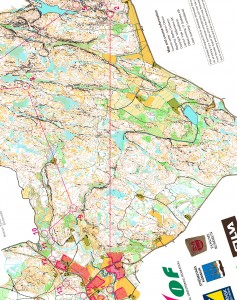
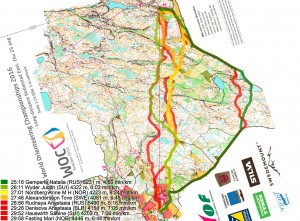
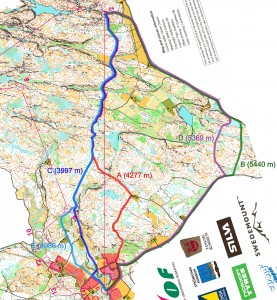
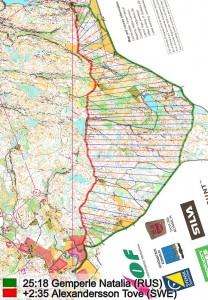

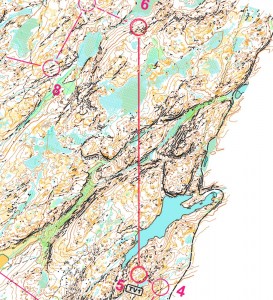

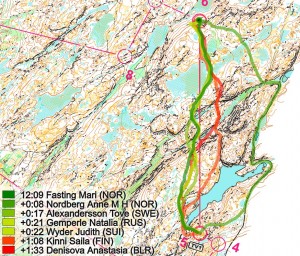
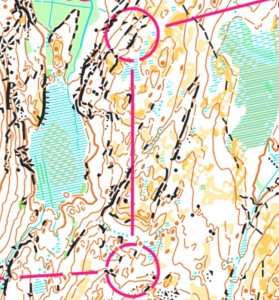
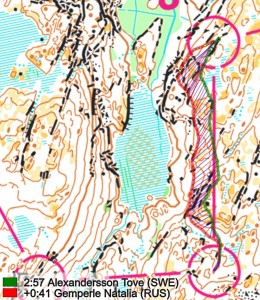
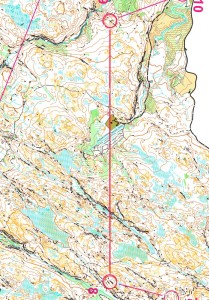
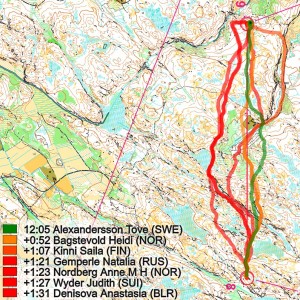
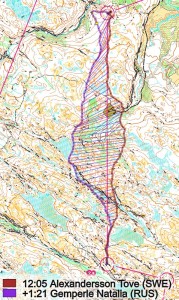
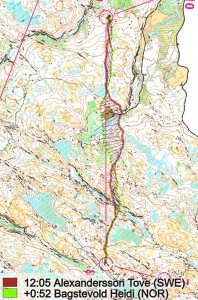
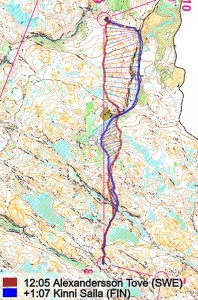
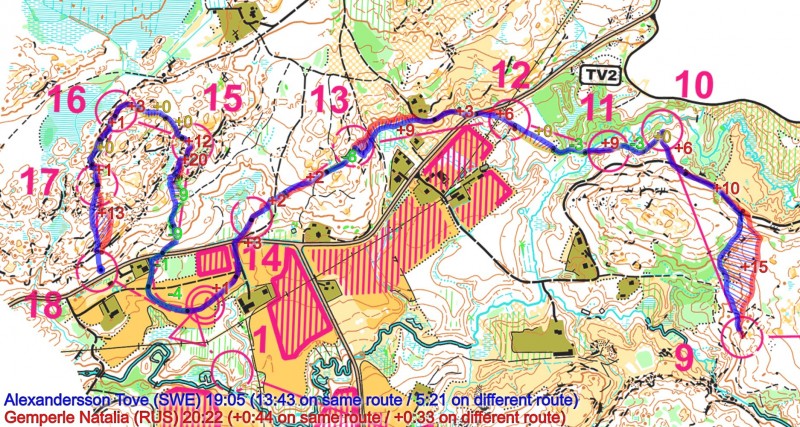
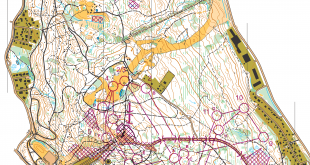
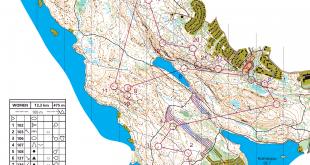
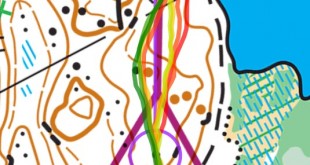
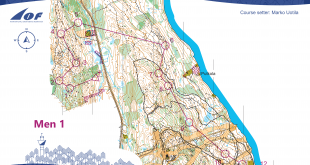
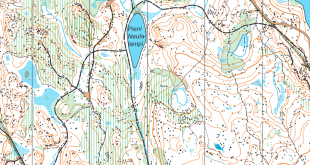
Regarding the Gemperle/Wyder, it looks from the GPS tracking and TV-pictures that Wydith was indeed in front most of the course from control 3, even though Gemperle punched first a few times. Towards control 6 it looks like Wyder with Gemperle closely behind runs very fast (and faster than Alexandersson on a similar route-choice) until she (they) makes a mistake into the control. For me this is the crucial point where Alexandersson switches the momentum in the race. Else there is one typo, Alexandersson started (of course) after Nordberg not before as written one place.
Here are the reasons why (all) the women, and more of the men should run the route to the right to control 2nd: with the terrain/road speed ratio in this terrian, it is faster, at least not slower. It saves energy on a long and physical course, and you will be paid back towards the end. It gives ample time to study the course ahead, identify critical points, and decide route choice on key legs. With slow entry speed (uphill), the control itslef isn’t that difficult.